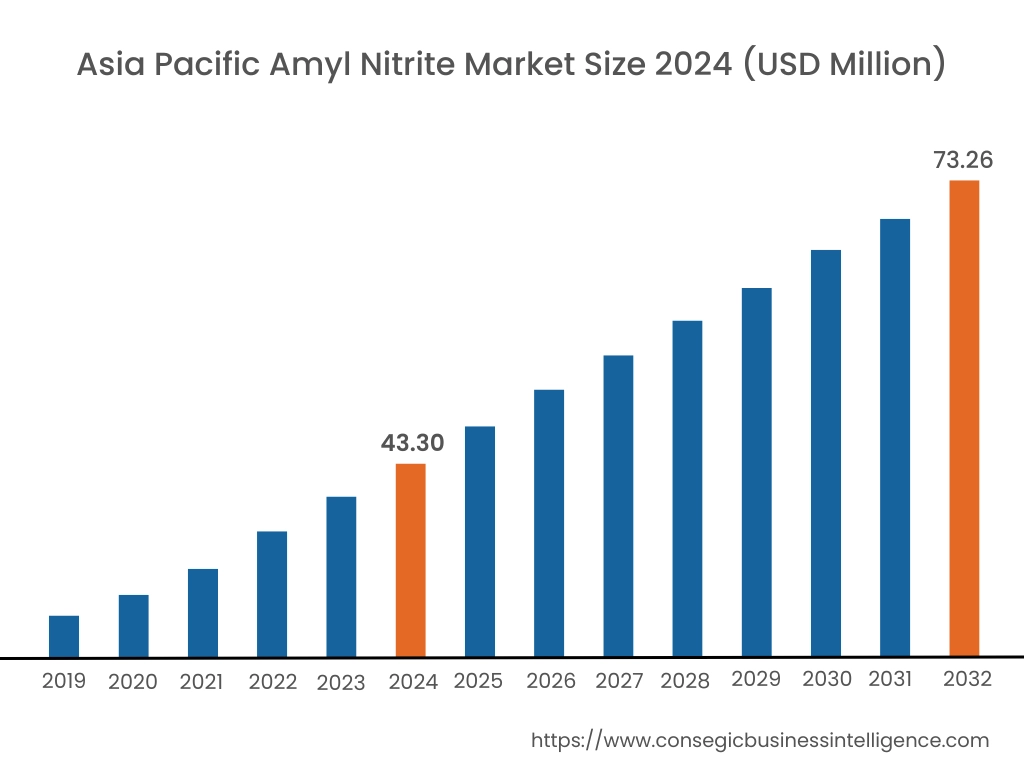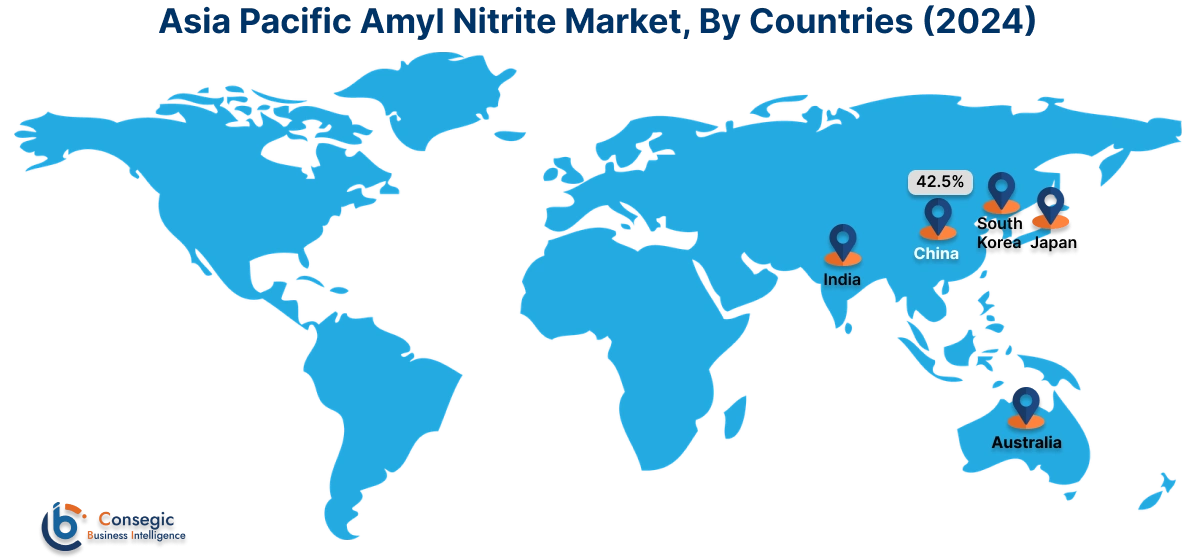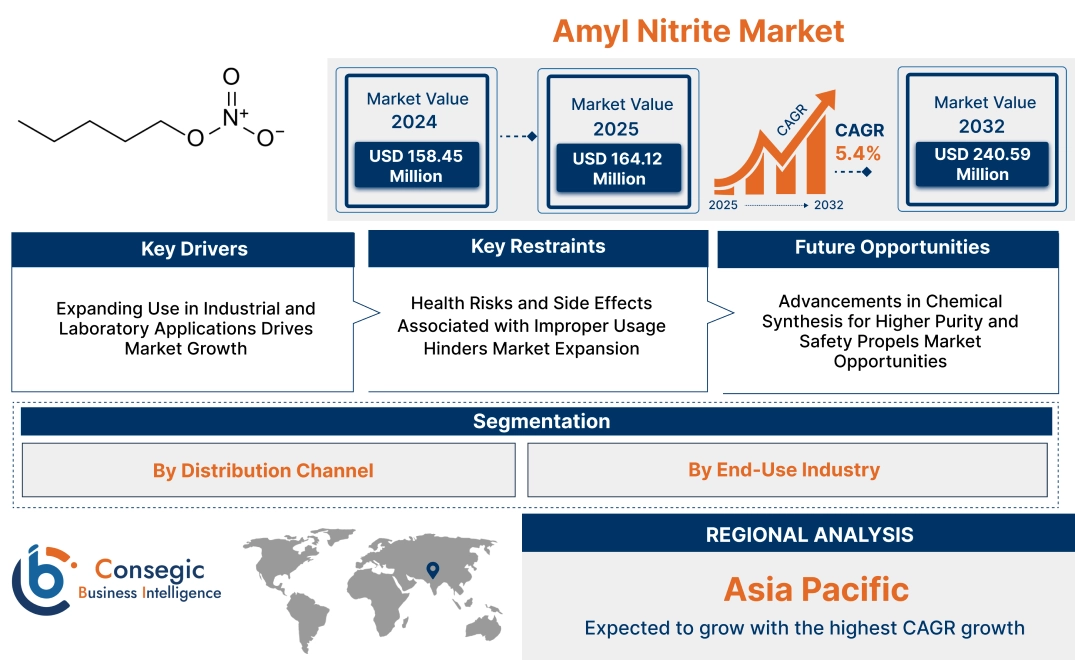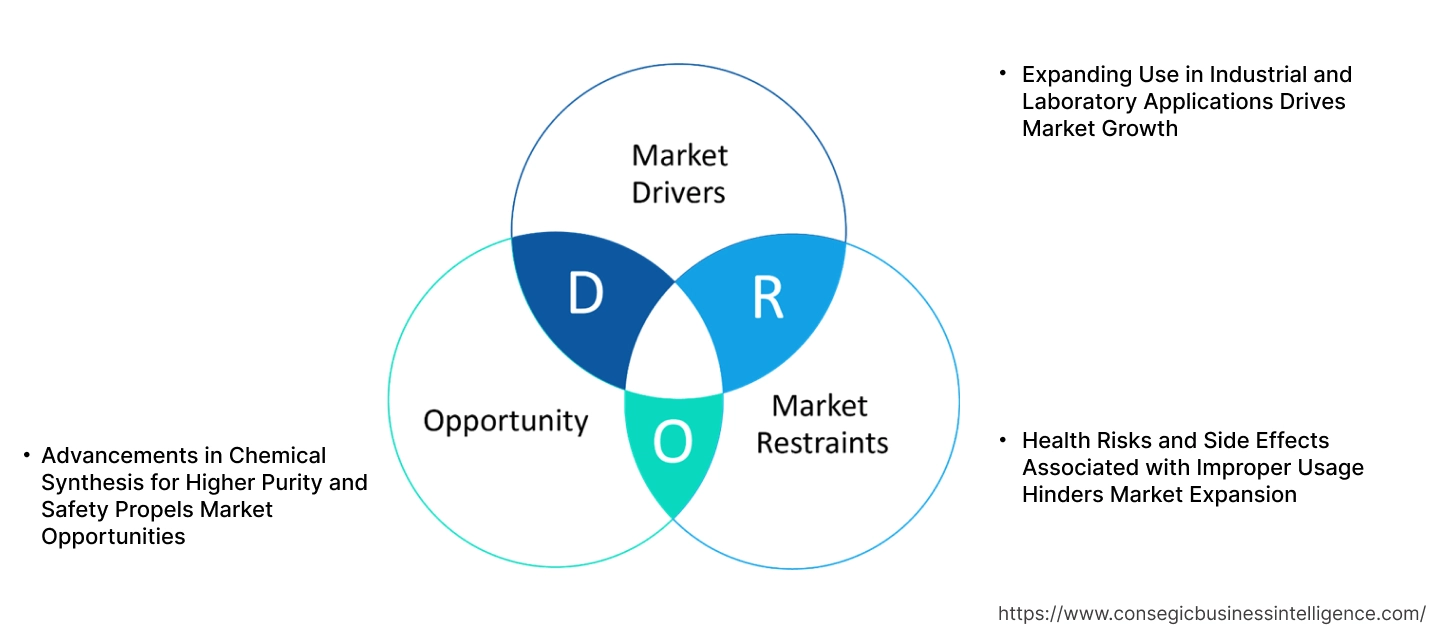- Summary
- Table Of Content
- Methodology
Amyl Nitrite Market Size:
Amyl Nitrite Market size is estimated to reach over USD 240.59 Million by 2032 from a value of USD 158.45 Million in 2024 and is projected to grow by USD 164.12 Million in 2025, growing at a CAGR of 5.4% from 2025 to 2032.
Amyl Nitrite Market Scope & Overview:
Amyl nitrite is a volatile organic compound derived from amyl alcohol and nitric acid. It appears as a pale yellow liquid with a distinct fruity odor and is known for its rapid vaporization. The compound acts as a vasodilator, relaxing smooth muscles and promoting blood flow, making it valuable in therapeutic and laboratory settings.
Key characteristics include high volatility, lipid solubility, and rapid onset of action. Its distinct odor and fast-acting properties make it suitable for controlled applications requiring immediate physiological or chemical reactions. It is primarily utilized in medical formulations, chemical synthesis, and specialized industrial processes.
Pharmaceutical manufacturers, research laboratories, and chemical industries incorporate it in regulated applications where precision and effectiveness are required. Continuous advancements in formulation and handling techniques ensure its safe and efficient use across various specialized sectors.
Key Drivers:
Expanding Use in Industrial and Laboratory Applications Drives Market Growth
Amyl nitrite is widely utilized in synthetic chemistry, pharmaceutical research, and analytical testing, making it a valuable compound for chemical synthesis and biochemical studies. Laboratories use it as a reagent in organic reactions, spectroscopy, and controlled oxidation processes, while industrial applications benefit from its solvent and intermediate properties. The rise in scientific advancements and pharmaceutical innovation has further bolstered its usage in research institutions and medical testing. Additionally, industries such as textiles, polymers, and coatings are incorporating it into specialized formulations to achieve enhanced performance and chemical stability in final products. With growing investments in advanced research and high-precision manufacturing, the role of this compound in regulated scientific and industrial environments is expected to expand. Therefore, these factors are set to drive amyl nitrite market expansion, reinforcing its importance across multiple sectors.
Key Restraints:
Health Risks and Side Effects Associated with Improper Usage Hinders Market Expansion
When used improperly, amyl nitrite can lead to dizziness, low blood pressure, respiratory distress, and cardiovascular complications, raising safety concerns among regulatory agencies. Inappropriate usage has also been linked to dependency and recreational abuse, prompting governments to impose strict distribution controls and legal restrictions. Manufacturers must comply with rigorous safety protocols, labeling requirements, and medical usage guidelines, which increase production costs and limit widespread accessibility. Additionally, public health campaigns against substance misuse and unregulated distribution have negatively impacted market perception, restricting adoption in certain regions. To mitigate these risks, the sector is focusing on controlled formulations and regulated pharmaceutical applications. Addressing safety concerns through medical-grade production and responsible distribution is essential for sustaining amyl nitrite market growth, ensuring its availability for legitimate industrial and healthcare applications.
Future Opportunities:
Advancements in Chemical Synthesis for Higher Purity and Safety Propels Market Opportunities
Manufacturers are investing in advanced synthesis techniques, precision refining, and contamination-free processing methods to enhance product quality. These advancements ensure greater chemical stability, controlled reactivity, and improved safety in medical and industrial applications. The growth of pharmaceutical research and high-performance chemical manufacturing is further fueling the adoption of refined amyl nitrite formulations that meet strict purity and regulatory standards. Additionally, new methods of controlled-release formulations and enhanced stabilization are increasing its effectiveness while minimizing risks. Industries focused on organic synthesis, medical treatments, and laboratory-grade reagents are benefiting from these improvements, expanding the compound's applications in critical scientific and medical advancements. As research into safe and efficient chemical production continues, these developments will unlock significant amyl nitrite market opportunities, positioning it as a valuable component in regulated industries.
Amyl Nitrite Market Segmental Analysis :
By Distribution Channel:
By distribution channel, the amyl nitrite market is segmented into direct sales, pharmaceutical distributors, and online retail.
The pharmaceutical distributors’ segment held the largest amyl nitrite market share in 2024.
- Pharmaceutical distributors play a crucial role in ensuring regulated supply, particularly in healthcare and pharmaceutical applications.
- The need for reliable distribution networks is increasing as regulatory bodies impose strict controls on its sale and use.
- Market analysis highlights that pharmaceutical distributors dominate the market, ensuring compliance with medical safety standards.
- As per amyl nitrite market trends, collaborations between pharmaceutical manufacturers and distributors are enhancing product availability across regions.
The online retail segment is expected to experience the fastest CAGR during the forecast period.
- E-commerce platforms and online pharmaceutical retailers are gaining traction, providing easy access to amyl nitrite for both medical and research purposes.
- The demand for convenient purchasing options is rising, particularly among research institutions and laboratories seeking direct access to chemical compounds.
- As per segmental trends analysis, regulatory scrutiny on online sales is increasing, ensuring product safety and controlled distribution.
- Thus, with growing digitalization in pharmaceutical sales, this segment is contributing to amyl nitrite market expansion.
By End-Use Industry:
By end-use industry, the market is segmented into healthcare, pharmaceuticals, research & laboratories, and others.
The healthcare segment held the largest amyl nitrite market share of 35.7% in 2024.
- Amyl nitrite is primarily used in the healthcare sector as an emergency vasodilator for treating angina and cyanide poisoning due to its rapid action and effective inhalation-based delivery.
- It plays a critical role in acute care settings, particularly in cardiac emergency response and toxicology units.
- Deeper regulatory approval and streamlined clinical protocols have facilitated consistent demand from hospitals and emergency departments.
- According to amyl nitrite market trends, the compound’s role in cardiovascular therapeutics underpins its dominance in this segment.
The research & laboratories segment is expected to have the fastest CAGR during the forecast period.
- Amyl nitrite is used in laboratory research and chemical synthesis, making it essential for various scientific applications.
- The demand for high-purity chemicals in research settings is growing as chemical and medical studies expand.
- Market trends indicate that universities, laboratories, and chemical research facilities are increasing their procurement of specialty compounds.
- Therefore, with expanding research in organic chemistry and medical sciences, this segment is contributing to amyl nitrite market growth.

Regional Analysis:
The regions covered are North America, Europe, Asia Pacific, the Middle East and Africa, and Latin America.

Asia-Pacific region was valued at USD 43.30 Million in 2024. Moreover, it is projected to grow by USD 45.27 Million in 2025 and reach over USD 73.26 Million by 2032. Out of this, China accounted for the maximum revenue share of 42.5%. The Asia-Pacific region is witnessing steady growth in the amyl nitrite industry, driven by expanding healthcare infrastructure and industrial development. Countries like China, Japan, and India contribute significantly, utilizing the compound in pharmaceutical manufacturing and chemical synthesis. The rising awareness of emergency medical treatments and an increase in research activities exploring its alternative uses further strengthen the market’s potential. This region remains a key area for market expansion due to evolving regulatory frameworks and increasing amyl nitrite market demand.

North American is estimated to reach over USD 77.98 Million by 2032 from a value of USD 52.56 Million in 2024 and is projected to grow by USD 54.34 Million in 2025. The North American market is characterized by stringent regulations and controlled medical use of amyl nitrite. The demand in this region is driven primarily by the pharmaceutical sector, where it is used for treating conditions like angina. Additionally, its role in chemical synthesis and industrial applications supports market expansion. The United States leads in research and development initiatives focusing on safer formulations, which are influencing the region’s amyl nitrite market demand.
In Europe, the market is regulated under strict medical guidelines, with controlled availability in pharmaceuticals and industrial applications. Countries such as Germany, France, and the UK are significant players, utilizing it in both medical and chemical sectors. The increasing focus on advanced medical treatments and compliance with EU safety regulations influence market dynamics. Additionally, ongoing studies exploring its broader therapeutic applications create a long-term amyl nitrite market opportunity.
As per amyl nitrite market analysis, Latin America is an emerging market, with growing interest from the pharmaceutical and industrial sectors. Brazil and Mexico are key contributors, where medical institutions are gradually incorporating the compound into specific treatments. The region is also seeing investments in chemical industries that use the compound for various synthesis applications. While regulatory policies are still evolving, market accessibility and increasing awareness may contribute to future growth.
According to the amyl nitrite market analysis, The Middle East and Africa region represents a developing market, with applications in both the medical and chemical industries. The demand is influenced by the region’s focus on expanding healthcare services and industrial production. Countries in the Gulf region are investing in pharmaceutical research, while African nations are exploring new opportunities for chemical manufacturing. Although regulatory challenges exist, the potential for controlled medical applications may create future market growth in these regions.
Top Key Players & Market Share Insights:
The amyl nitrite market is highly competitive with major players providing products and services to the national and international markets. Key players are adopting several strategies in research and development (R&D), product innovation, and end-user launches to hold a strong position in the global amyl nitrite market. Key players in the amyl nitrite industry include -
- Merck KGaA (Germany)
- Thermo Fisher Scientific Inc. (USA)
- Tokyo Chemical Industry Co., Ltd. (Japan)
- Central Drug House (P) Ltd. (India)
- Alfa Aesar (USA)
- Penta Manufacturing Company (USA)
- BASF SE (Germany)
- Toronto Research Chemicals (Canada)
- Loba Chemie Pvt. Ltd. (India)
- Sigma-Aldrich Corporation (USA)
Amyl Nitrite Market Report Insights:
| Report Attributes | Report Details |
| Study Timeline | 2019-2032 |
| Market Size in 2032 | USD 240.59 Million |
| CAGR (2025-2032) | 5.4% |
| By Distribution Channel |
|
| By End-Use Industry |
|
| By Region |
|
| Key Players |
|
| North America | U.S. Canada Mexico |
| Europe | U.K. Germany France Spain Italy Russia Benelux Rest of Europe |
| APAC | China South Korea Japan India Australia ASEAN Rest of Asia-Pacific |
| Middle East and Africa | GCC Turkey South Africa Rest of MEA |
| LATAM | Brazil Argentina Chile Rest of LATAM |
| Report Coverage |
|
Key Questions Answered in the Report
How big is the Amyl Nitrite Market? +
Amyl Nitrite Market size is estimated to reach over USD 240.59 Million by 2032 from a value of USD 158.45 Million in 2024 and is projected to grow by USD 164.12 Million in 2025, growing at a CAGR of 5.4% from 2025 to 2032.
What specific segmentation details are covered in the Amyl Nitrite Market report? +
The Amyl Nitrite market report includes specific segmentation details for distribution channel and end-use industry.
Which is the fastest-growing region in the Amyl Nitrite Market? +
Asia Pacific is the fastest-growing region in the Amyl Nitrite market. These trends are encouraged by expanding healthcare infrastructure and industrial development.
Who are the major players in the Amyl Nitrite Market? +
The key participants in the Amyl Nitrite market are Merck KGaA (Germany), Thermo Fisher Scientific Inc. (USA), BASF SE (Germany), Toronto Research Chemicals (Canada), Loba Chemie Pvt. Ltd. (India), Sigma-Aldrich Corporation (USA), Tokyo Chemical Industry Co., Ltd. (Japan), Central Drug House (P) Ltd. (India), Alfa Aesar (USA) and Penta Manufacturing Company (USA).


